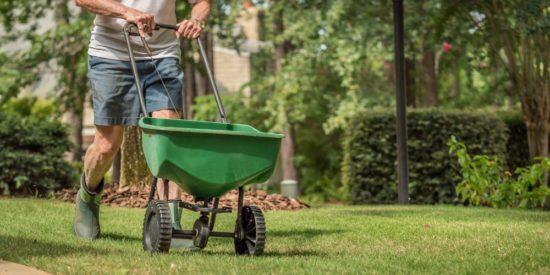Fertilising your lawn in spring
Fertilising your lawn during the spring months is vital. It helps to provide the turf with all the essential nutrients it needs to grow healthily and deal better with disease and weather extremes.
It is important, however, to make sure that fertiliser is applied correctly. If applied at the wrong times of year, it can negatively effect your turf. Similarly, knowing what fertiliser to use is also important. If you apply a fertiliser that is high in a nutrient your soil is okay or on the borderlines of being high in, it can overdose the area in that nutrient and have a negative impact. To avoid this from happening, a soil analysis for lawns is a great option. From this you will be able to see exactly what your area needs as well as receiving a tailored treatment plan outlining the best products to us.
Understanding what the numbers on your lawn fertiliser mean
Whether you are fertilising your lawn in spring or autumn, your fertiliser will have numbers on referring to the N:P:K ratio. N:P:K refers to the three main plant nutrients that are in your fertiliser: Nitrogen (N), Phosphorous (P) and Potassium (K). These help you to choose which fertiliser is best for your situation.
How to know what spring fertiliser to apply
When trying to decide on a fertiliser, the choice can be overwhelming. During spring, a balanced fertiliser such as the Amvista G3 Spring/Summer Fertiliser is a great option as it helps lawns to be able to better withstand common problems such as weeds, moss and disease as well as helping to improve the appearance of your grass.
Another great option for spring fertilising is our Amvista G4 Advanced Feed, Weed and Moss Killer. This an 'all-in-one' product that fertilises your lawn while also providing a moss and weed kill element.
When should you apply spring fertiliser
We would recommend applying your spring fertiliser around mid-spring (late March - April) before the hotter summer weather arrives. Ideally you will want soil temperatures to be around 12⁰C - you can tell when we have reached this point as this is generally when grass begins to grow a lot more!
Once we reach the end of September, we advise to not use spring/summer fertilisers as they contain too much nitrogen for the autumn period. This is because nitrogen encourages lush growth which is not something that is wanted in colder weather.
If you still require any further advice on fertilising your lawn this spring, be sure to contact one of our technical advisors and they would be happy to assist you.





